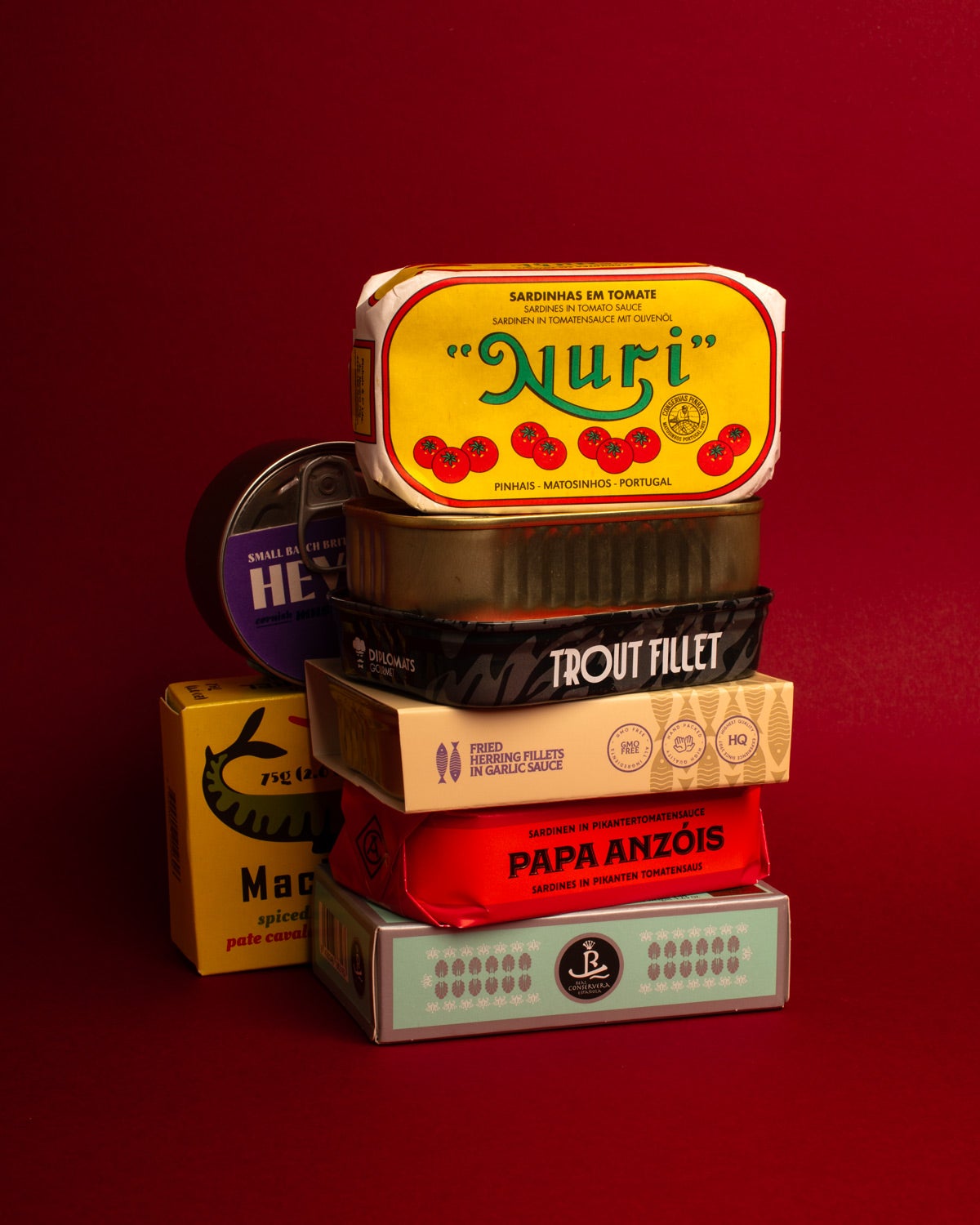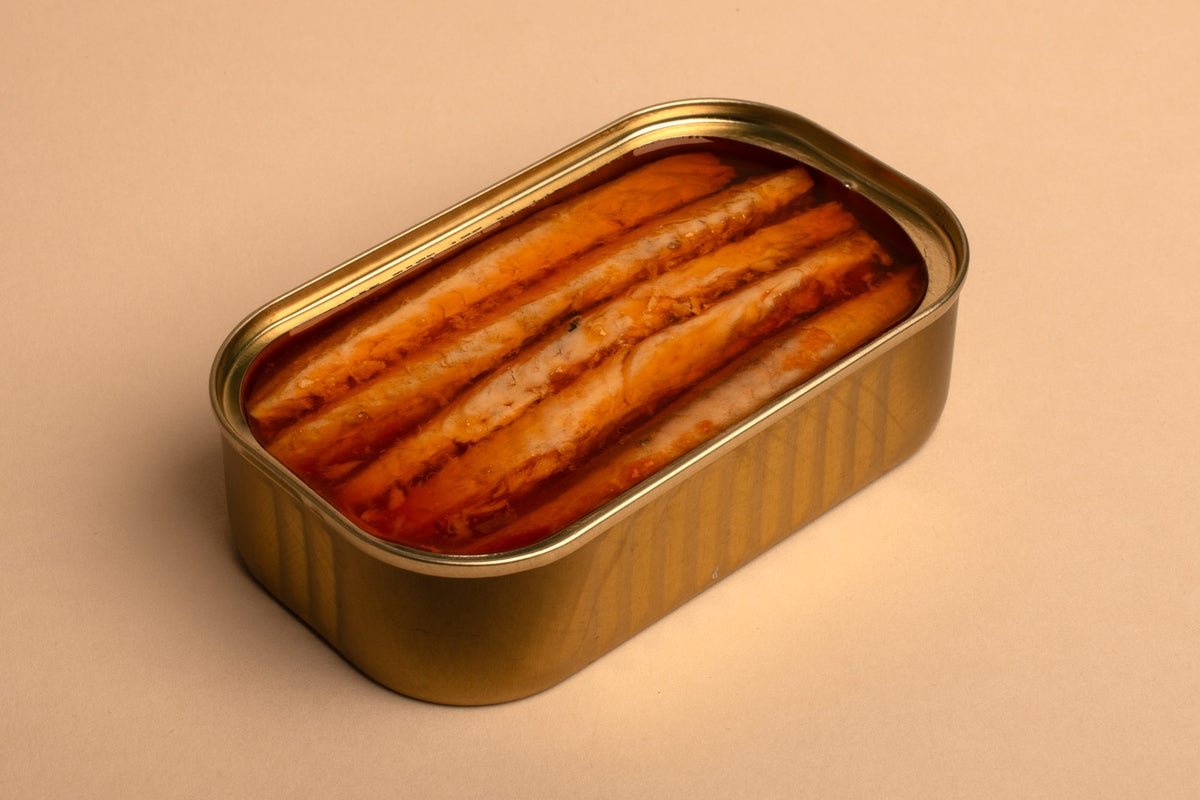If you’ve browsed the shelves at your local deli lately – or spotted tins of sardines wrapped like tiny presents on social media – you’ll know tinned fish is having a moment. Once dismissed as a back-of-the-cupboard back-up, it has improbably become one of Britain’s chicest grocery indulgences.
Few people understand this transformation better than Patrick Martinez, founder of The Tinned Fish Market, in Borough Market, London, who has quietly built a following for tins as both an everyday staple and a holiday keepsake ever since lugging a couple of suitcases of sardines back from Portugal.
In Martinez’s world, these tins aren’t just for lunch boxes. They’re small treasures to hoard, gift or show off on Instagram. They are, he says, “almost like a gold bar” – an edible collectable that happens to pair well with crisps and a glass of cold white wine.
When he first started, “the tinned fish space in the UK was really boring”, Martinez tells me. “Really, what I wanted to do was present it to the world in a more high-end way. It was a quality product that I was bringing here and it really deserved to be marketed that way.”
So he did – first lugging two suitcases of Portuguese tins back to his living room in Liverpool in 2018, then hawking them at markets and online. People were intrigued. Grandads who missed pilchards, students who’d eaten tapas in Barcelona, young chefs wanting to impress on TikTok: suddenly, everyone wanted a tin.
“In the beginning, the irony of it was definitely an element of interest,” he says, “A low-end product being marketed in a high-end way, but I think what happened was there was a lack of knowledge in the UK. People just didn’t know it very well.”
It’s easy to see why it caught on. Britain loves a good deli counter: cheeses, charcuterie, things that keep. Tinned fish slots neatly alongside. “The British consumer loves their cheeses, cured meats, tapas, so I always thought there was room for a new category.”
But maybe there’s something else at play. In a world exhausted by fast food and scandalously long ingredient lists, a tin of tuna in extra-virgin olive oil feels refreshingly simple. It’s a rare thing: unpretentious but vaguely exotic, convenient but also a conversation starter.

“It’s simple, not ultra-processed – often the fish and quality olive oil are the only ingredients. It’s sustainable, the way it’s caught, the amount taken from the sea,” says Martinez. “There’s the provenance, too. One side of provenance is sustainability and traceability, the other side is about being exotic. It implies it comes from far away – from the Cantabrian Sea or Galician estuaries. It’s almost poetic.”
Of course, nostalgia helps. As Martinez points out, plenty of us remember pilchards and sardines from kitchen cupboards long before they were hip. But now, thanks to bright wrappers and retro branding, they’re also ready-made for social media. He says some customers have enormous collections of tins, proudly on display.
Once you notice it, the parallels with fashion are obvious. Martinez doesn’t just stock tins, he curates drops – seasonal, limited, collectable. “I think there’s a parallel between the fashion world and our food business because fashion brands are experts at creating seasonal products,” he says. “You don’t buy all your wardrobe from Louis Vuitton or all from H&M, and we see that in our orders too – an average order for us is staples and a couple of unusual tins or tins that are more of a treat or an exclusive.” Like Los Peperetes, a Spanish label revered by aficionados. It was founded in 1993 by Jesús Lorenzo Crespo, grandson of Galicia’s first canners, who began preserving the best cockles and sardines he could find, producing just 30 tins a day and sealing each one by hand.
For Martinez, it’s not just hype – it’s craft. His tins come from small-batch, family-run canneries in Portugal and Spain, some of whom wait months for the right fish, then clean and pack every fillet by hand. They’ve just started stocking hake cheeks from Alalunga in Cantabria, “which is a very scarce delicacy”, and Angelachu’s anchovies in butter, “which is how they used to be preserved in the old days”. Sourcing these tins is an obsession. It’s why you’ll pay £20 or more for a tin of sea urchin – and why it’s worth it.
“At the shop, we start by saying the cornerstone of it all is that the very best fish go in the tins, all prepared by hand, which means the quality control is very high and the recipes have a home-cooked feel,” he says. “We are very careful to justify the prices. With the sea urchin, we stress that there is limited availability and that it’s a labour-intensive tin to produce.”

And yes, that retro branding matters, too. “The short answer is the content has nothing to do with the aesthetics of the packaging. However, some of the packaging is really beautiful. They make our shop and website look so colourful,” says Martinez.
“At the end of the day, tinned fish is something that comes in a boring, plain tin, so the canneries have to make it appealing.”
For the sustainability-minded, tinned fish ticks boxes too – but not all tins are created equal. “Tinned fish is sustainable on many, many levels – the shelf life is incredibly long, it’s stable at room temperature, you don’t need to refrigerate it, you don’t need to cook it and use energy there either,” Martinez explains.
What makes some tinned fish more sustainable than others is the way it’s been caught and where. “With tuna, the best choices are pole and line caught Cantabrian tuna, or skipjack from the Atlantic. Sardines are seasonal – they’re fished May to November in Portugal – if the quota is reached before the end of November, all fishing of sardines stops, so when you’re eating Portuguese sardines, you know they’re not being overfished.” For importers like Martinez, they require a catch certificate for every tin, ensuring that every single one is traceable. “We know how much was taken out of the sea, which fishery they came from, which boat caught them.”
For those just dipping a toe in – or nervously eyeing that £12 tin of mussels – Martinez has advice. “I give customers three options, really different to each other – the classic sardines in olive oil, then one in an interesting sauce like the tuna with chimichurri, and then a slightly more adventurous tin like mussels. I’d probably save the baby eels or goose barnacles for their second visit!”
He also tells customers about the big five ways to eat tinned fish: with bread, salad, pasta, rice and crisps. Oh, and wine.

His desert island tin? The one he’d pack for any holiday? No question: “The tuna fillets from Santa Catarina – it’s such quality, it’s great every time, I can use it is as is to finish a salad in summer, or in winter with chickpeas and roasted pepper with something more like a stew, and it’s part of my own tinned fish paella!”
At home, Martinez follows his own advice. “I’m a passionate cook and foodie so you’ll find me at home dreaming up recipe ideas. But, to be honest, and don’t tell anyone this, I think the less you do with the tins, the better.”
The Tinned Fish Market is at Borough Market and online at thetinnedfishmarket.com. Consider yourself warned: once you start collecting, you may never stop.
Five quick and easy tinned fish recipes
Anchovey brioche
1. Toast half a brioche bun.
2. Slather with plenty of unsalted butter.
3. Top with two large anchovy fillets.
4. Garnish with nigella seeds.
Cod pasta
1. Soften diced onion and chilli in olive oil.
2. Add a tin of cod in Galician sauce.
3. Add 2 tablespoons of mascarpone cheese and blend, reserving a little of the mixture.
4. Add tagliatelle and stir together with the remaining mixture and plate.
5. Top with the reserved cod mixture and garnish with toasted pine nuts.
Soft-boiled egg on herring
1. Oven-roast a red pepper, peel and cut into thick slices.
2. Place a couple of slices on a plate and top with herring fillets.
3. Add a soft-boiled egg.
4. Season to taste.
Chickpea and mussels
1. Soften sliced red onion and minced garlic in a little oil over a low heat.
2. Add salt and smoked paprika to taste and jarred chickpeas. Add the escabeche from the tin and stir gently to create a salsa – don’t cook for too long, as you don’t want it to overly reduce.
3. Add the mussels at the last minute to warm through.
4. Garnish with parsley.
Salmon potato salad
1. Peel potatoes and slice by hand to get a more uneven, rustic shape.
2. Boil in salted water for five minutes, drain and cool on a tea towel.
3. Mix with mayo.
4. Top with a salmon fillet, and season to taste with salt and pepper. Pour the oil from the tin over the salmon and potato salad, garnish with dill and serve with lemon wedges.
#tinned #fish #coolest #cupboard



